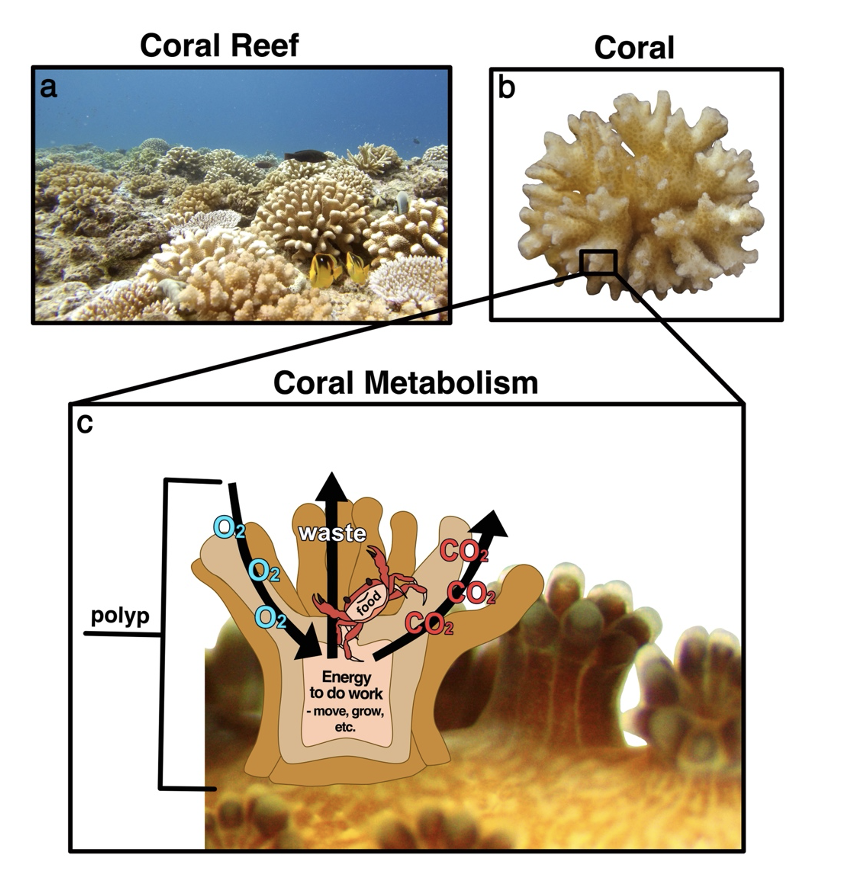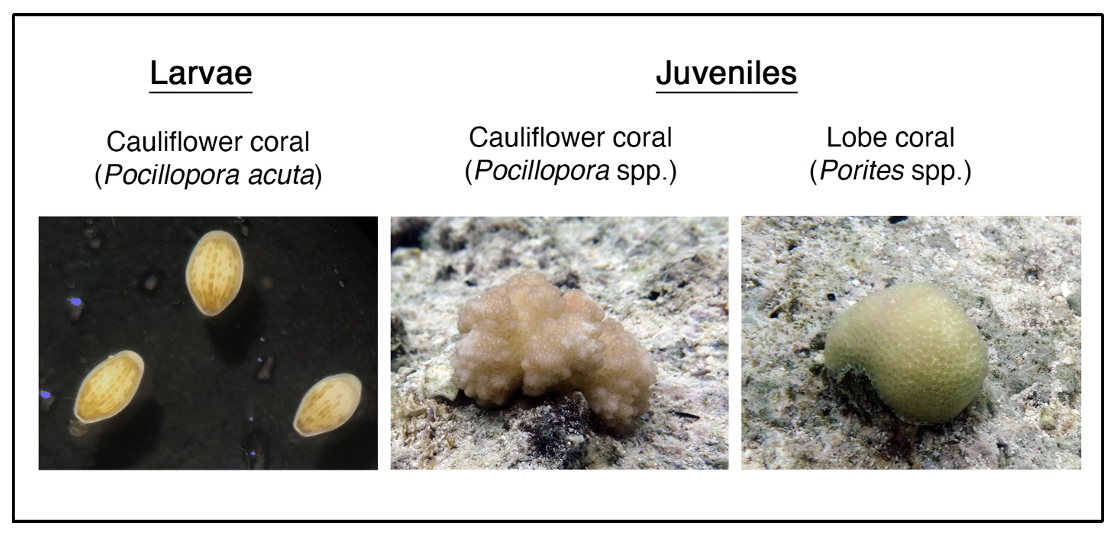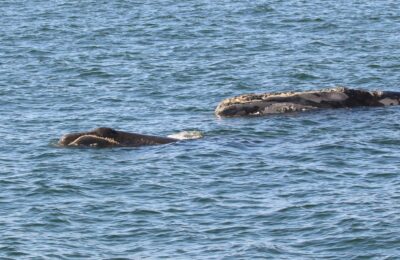This is a guest post by Nina Bean. Nina is a 2nd year master’s student at the California State University, Northridge in Dr. Peter Edmunds’ Polyp Lab. She is studying how coral traits and competitive outcomes scale with coral size at various life stages.
Nina is a 2nd year master’s student at the California State University, Northridge in Dr. Peter Edmunds’ Polyp Lab. She is studying how coral traits and competitive outcomes scale with coral size at various life stages.
Corals are threatened by increasing stressors including elevated temperatures, ocean acidification and disease. These stressors have caused changes in the number and size of organisms such as big corals dying, shrinking, and/or breaking up into smaller individuals which has led to smaller corals instead of bigger ones. These observations give rise to an interesting question – does coral size matter? Are two small corals the same thing as one big coral? Or is the whole greater than the sum of its parts? My research is based in Mo’orea, French Polynesia where I study how coral metabolism (the sum of chemical reactions in cells that provide energy for building organic material) changes with coral size.

Some background on size
An exciting frontier in ecology, called metabolic scaling theory, explores how metabolic rate, which is similar to breathing in humans, changes depending on how big an organism is. For example, since an elephant is 1000x larger than a mouse, would you expect the elephant to breathe 1000x more than a mouse? Even though an elephant breathes more than a mouse because it needs more energy, it actually breathes less relative to its body size. This means the elephant uses energy more slowly and is therefore much more energy efficient compared to the mouse.
Metabolic scaling has been well studied in organisms that grow to a certain size and possess a fixed number of body parts (e.g., 2 arms, 2 legs) such as humans and elephants. Metabolic scaling has been less studied in organisms that not only grow, but also shrink and divide like corals. A coral colony is an animal made up of many polyps that are all clones (i.e., they are genetically identical) of each other. A polyp looks like a cylinder with a crown of tentacles on top. A colony grows by forming new polyps, shrinks when polyps die, and divides when polyps are separated from each other. Since corals are composed of repeating polyps that increase in number as the coral grows, it raises the question, of whether large corals simply are additions of their smaller counter parts? My research aims to answer this question by exploring how metabolism changes with coral size on the reefs of Mo’orea, French Polynesia.
What did I do?
Metabolic scaling was explored in the early life stages of corals, specifically the larval and juvenile (before reaching reproductive maturity) stages. The larval stage is like the baby stage when the coral is a free-swimming larva which then proceeds to settle on the reef floor and transforms into a single polyp in a similar manner to the way in which a caterpillar transforms into a butterfly. The polyp then forms new polyps next to it and develops into the juvenile stage which is like the teenage stage. I measured the respiration rate of cauliflower coral (Pocillopora acuta) larvae and small colonies (i.e., juveniles) of cauliflower coral (Pocillopora spp.) and lobe coral (Porites spp.) by placing the coral in a known volume of water and monitoring the amount of oxygen they use to “breath”. I used photographs to measure larval size. To obtain the juvenile size, I weighed the coral tissue and measured the dimensions of the coral surface area.

Research findings
Through investigating both large and small cauliflower coral larvae and lobe coral juveniles, I found that larger individuals respire more, but relative to body size, they respire less than smaller individuals. In contrast, cauliflower coral juvenile respiration relative to body size remained the same as corals became larger. In addition, the weight of coral tissue on the surface of each colony, which reflects how thick the layer of tissue has become, increased with increasing size in lobe coral juveniles, but remained the same across sizes in cauliflower coral juveniles.
What do the results mean?
It was found that respiration rate relative to body size decreased in cauliflower coral larvae and lobe coral juveniles. This points to the possibility that as individuals of these groups get larger, they carry around proportionally more tissue that does not metabolize (i.e. fat) leading to decreased respiration rates. Larger larvae may have been supplied with more fat from their mothers, and lobe coral juveniles may accumulate more fat as they grow which explains the increasing tissue thickness with colony size. Cauliflower coral juveniles on the other hand maintained the same respiration rate relative to body size. This fact, along with the constant tissue thickness, could be because the percentage of fat stays the same as these particular corals grow. The difference in metabolic efficiencies and tissue thickness over colony size in lobe and cauliflower coral juveniles may reflect their different survival strategies. The strategy of the lobe coral is to initially grow fast but then to slow down so it can invest in fat storage. On the other hand, the cauliflower coral tends to constantly grow fast without accumulating much fat.
Why is this important?
Since larger larvae were found to be more energetically efficient, they might be able to survive longer and disperse farther in order to colonize degraded reef habitats. As the lobe coral became larger, their tissue thickness and metabolic efficiency increased, indicating they may be more resilient to stressors. In contrast, the cauliflower coral might be less resilient as observed through its constant tissue thickness and metabolic efficiency despite a size increase. Understanding the differences between small and large corals across different species and life stages can lead to more accurate predictions about the future of our coral reefs. These coral reefs provide many ecosystem functions such as habitat for fish and protection from shoreline erosion. Thus, it is important to study coral size, what species will be found where and how resilient they can be especially in the face of climate change.
Further reading
To learn more about how coral age and size affects growth and death rates and how sometimes small corals can be old and large corals can be young, you can read, “Population Dynamics Based on Size or Age? A Reef-Coral Analysis“. To learn more about how coral size affects how fast corals build their skeleton, respire and photosynthesize across varying degrees of temperature and ocean acidification, check out “Correction: Size-dependent physiological responses of the branching coral Pocillopora verrucosa to elevated temperature and PCO2″.
Acknowledgements
California State University, Northridge, Mo’orea Coral Reef Long Term Ecological Research, National Science Foundation (NSF), The Polyp Lab, NSF grants — OCE 16-37396 for Mo’orea
Permitting
Research in Mo’orea was conducted under permits issues by the Haut-Commissariat de la République en Polynésie Francaise (DTRT) (Protocole d’Accueil 2005–2019). Colonies collected for larval release were returned to the reef after spawning.
I love writing of all kinds. As a PhD student at the Graduate School of Oceanography (URI), I use using genetic techniques to study phytoplankton diversity. I am interested in understanding how environmental stressors associated with climate change affect phytoplankton community dynamics and thus, overall ecosystem function. Prior to graduate school, I spent two years as a plankton analyst in the Marine Invasions Lab at the Smithsonian Environmental Research Center (SERC) studying phytoplankton in ballast water of cargo ships and gaining experience with phytoplankton taxonomy and culturing techniques. In my free time I enjoy making my own pottery and hiking in the White Mountains (NH).



